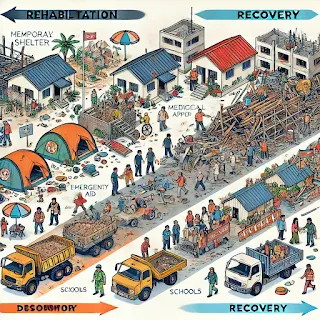Disaster management involves several phases, including mitigation, preparedness, response, recovery, and rehabilitation. Recovery and rehabilitation are post-disaster activities that aim to restore normalcy and improve resilience in affected areas.
1. Recovery
Recovery is the long-term process of rebuilding communities, infrastructure, economy, and social systems after a disaster. It focuses on restoring normalcy while incorporating resilience measures to withstand future disasters.
- Short-term Recovery – Immediate efforts within weeks or months to restore essential services (e.g., water, electricity, healthcare, shelter).
- Long-term Recovery – Efforts that take months to years, including rebuilding infrastructure, economic revitalization, and mental health support.
- Resilience – The ability of a community to recover quickly and adapt to future disasters.
- Livelihood Restoration – Providing economic support to affected populations through job creation, skill training, and financial assistance.
- Psycho-social Recovery – Addressing trauma, stress, and mental health impacts of disasters.
- Infrastructure Reconstruction – Rebuilding damaged roads, bridges, hospitals, and schools.
- Economic Recovery – Providing financial aid, loans, and policies to restore businesses and agriculture.
Example
- 2004 Indian Ocean Tsunami: Long-term recovery efforts included the reconstruction of houses, fishing boats, and economic support for affected communities.
- 2015 Nepal Earthquake: The government and NGOs provided financial support, rebuilt schools, and restored tourism-dependent economies.
2. Rehabilitation
Rehabilitation is the process of restoring the physical, social, and economic conditions of an affected community to at least pre-disaster levels. It focuses on providing temporary solutions before permanent recovery measures are implemented.
- Temporary Housing – Setting up relief shelters or camps for displaced populations.
- Medical Rehabilitation – Providing healthcare, prosthetics, and therapy to disaster survivors.
- Social Reintegration – Reuniting displaced families and providing psychological counseling.
- Environmental Rehabilitation – Restoring ecosystems, clearing debris, and managing waste.
- Cash-for-Work Programs – Engaging affected people in rebuilding efforts by providing financial incentives.
Example
- Hurricane Katrina (2005): Temporary shelters were set up, and medical rehabilitation was provided for injured victims.
- Uttarakhand Floods (2013): Government agencies set up temporary housing and provided psychological counseling to affected families.
Differences
| Aspect | Recovery | Rehabilitation |
|---|---|---|
| Objective | Long-term rebuilding and resilience | Short-term restoration of essential services |
| Timeframe | Months to years | Days to months |
| Focus | Infrastructure, economy, mental health, sustainability | Immediate shelter, healthcare, livelihood support |
| Outcome | Sustainable development and disaster preparedness | Basic functioning and stability |

Comments
Post a Comment